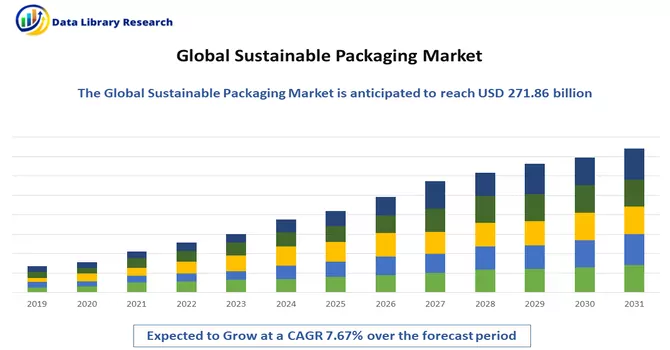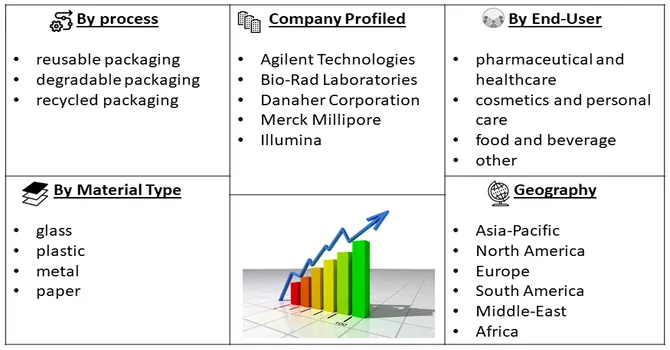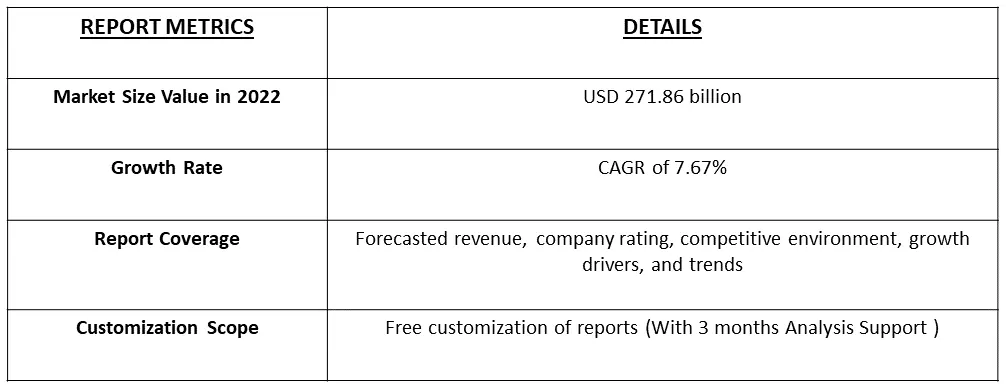The Sustainable Packaging Market size is expected to grow from USD 271.86 billion in 2023 to USD 393.39 billion by 2028, at a CAGR of 7.67% during the forecast period (2023-2028).

Get Complete Analysis Of The Report - Download Free Sample PDF
Sustainable packaging encompasses the design and utilization of packaging materials and methods aimed at enhancing overall sustainability. This approach involves a heightened emphasis on conducting comprehensive life cycle inventory (LCI) and life cycle assessment (LCA) studies to inform packaging choices and mitigate their environmental consequences. In essence, sustainable packaging involves the development and application of packaging solutions that contribute to a more eco-friendly and resource-efficient packaging industry.
The growing global awareness and concern for environmental issues, such as climate change, pollution, and resource depletion, have led to increased demand for packaging solutions that have a reduced impact on the environment. Moreover, shifting consumer preferences towards eco-friendly products and a desire for transparency in product packaging have driven companies to invest in sustainable packaging solutions to meet consumer demands.
The use of biodegradable, compostable, and renewable materials like plant-based plastics, paper, and bamboo for packaging continued to gain traction. An increased focus on designing packaging that is easily recyclable and creating closed-loop systems where packaging materials are collected and reused. Moreover, more companies were collaborating to create industry-wide sustainability standards and initiatives, promoting sustainability throughout the supply chain. These market trends are expected to drive the growth of the studied market.
Market Segmentation: The global sustainable packaging market is segmented by process (reusable packaging, degradable packaging, recycled packaging), material type (glass, plastic, metal, paper), end user (pharmaceutical and healthcare, cosmetics and personal care, food and beverage, other end users), and geography (North America, Europe, Asia-Pacific, Latin America, Middle East and Africa). The market sizes and forecasts are provided in terms of value (USD billion) for all the above segments.

For Detailed Market Segmentation - Download Free Sample PDF
Market Driver:
Government Initiatives toward Sustainable Packaging and Downsizing of Packaging
Sustainable packaging has gained significant attention globally as a response to environmental concerns, resource depletion, and the need to reduce waste in the packaging industry. Governments around the world are recognizing the importance of sustainable packaging and are taking initiatives to promote and regulate the use of eco-friendly packaging materials and practices. These government efforts are not only contributing to the reduction of environmental impact but also shaping the growth of the sustainable packaging market.
Many governments are implementing EPR programs, which make producers responsible for the management and recycling of their packaging materials. These programs encourage companies to adopt more sustainable and easily recyclable packaging to reduce their long-term environmental impact. Governments often run public awareness campaigns to educate consumers about the environmental impact of packaging choices. Informed consumers are more likely to favor products with sustainable packaging, which, in turn, drives market demand. Thus, due the above-mentioned reasons, the market is expected to witness significant growth over the forecast period.
Shift in Consumer Preferences toward Recyclable and Eco-friendly Materials
Consumer preferences are undergoing a significant transformation, driven by a heightened awareness of environmental issues and a growing sense of responsibility toward the planet. As a result, there has been a notable shift in consumer preferences toward products and packaging that are recyclable, eco-friendly, and sustainable. Consumers are increasingly concerned about the environmental impact of their choices. They seek products and packaging that are less harmful to the planet and contribute to reducing waste and pollution. The availability of information about product and packaging materials, sourcing, and manufacturing processes has empowered consumers to make more informed decisions. They are more likely to support brands that are transparent about their sustainability efforts. Thus, the market is expected to witness significant growth over the forecast period.
Market Restraints
Capacity Constraint of Manufacturing Plants and High Cost of Raw Materials
Sustainable packaging materials, such as biodegradable plastics or recycled paper, tend to be more expensive than their conventional counterparts. This cost disparity can lead to higher pricing for products packaged in a sustainable manner, which may deter price-sensitive consumers. Adapting manufacturing plants for the production of sustainable packaging can be complex and time-consuming. This often involves retooling and retrofitting machinery, which can disrupt production and incur additional costs. Thus, these factors are expected to slow down the growth of the studied market.
Segmental Analysis:
Reusable Packaging is Expected to Witness Significant Growth Over the Forecast Period
Reusable packaging is an approach that centers on designing and utilizing packaging materials that can be employed multiple times before they reach the end of their life cycle. These plastics break down into natural components when exposed to specific environmental conditions, reducing plastic waste. Fewer resources are needed to produce reusable packaging compared to continuously manufacturing single-use packaging. Sustainable packaging materials involve the use of eco-friendly substances and processes to create packaging solutions. These materials aim to minimize environmental harm and promote a more responsible approach to packaging. Thus, the segment is expected to witness significant growth over the forecast period.
Glass is Expected to Witness Significant Growth Over the Forecast Period
Glass has been a trusted and timeless material for packaging, prized for its durability, versatility, and its ability to preserve the integrity of the products it contains. In the context of sustainable packaging, glass stands out as an environmentally friendly option due to its unique characteristics and potential to contribute to more eco-conscious packaging practices. Glass production involves lower emissions compared to some other packaging materials, particularly plastics. Glass containers tend to have a lower carbon footprint, especially when the glass is locally sourced and manufactured. Glass is inert and impermeable, meaning it doesn't release harmful chemicals into the contents it holds. This is in contrast to certain plastics that can leach harmful substances into products. Thus, the segment is expected to witness significant growth over the forecast period.
Pharmaceutical and Healthcare is Expected to Witness Significant Growth Over the Forecast Period
The pharmaceutical and healthcare industry plays a critical role in ensuring the well-being of individuals worldwide. An essential aspect of this sector's responsibility is the proper packaging and delivery of medications, medical devices, and healthcare products. As environmental concerns and awareness of climate change grow, pharmaceutical and healthcare companies are recognizing their role in minimizing environmental impact. Sustainable packaging is viewed as an avenue to demonstrate corporate responsibility and reduce the sector's carbon footprint. Thus, the pharmaceutical and healthcare industry's embrace of sustainable packaging materials is a significant step towards reducing its environmental impact and meeting the demands of environmentally conscious consumers and regulatory bodies.
Asia-Pacific Expected to Have Significant Growth Over the Forecast Period
Chinese e-commerce giants and rapid delivery providers are actively working to reduce their reliance on packaging materials. For example, SF Express has adopted recyclable packaging boxes that can be reused about ten times. They've deployed over 100,000 of these boxes in major Chinese cities, replacing traditional paper boxes and plastic bags, and reducing the use of foam blocks and tape. These initiatives are aligned with the country's commitment to fostering sustainable growth in the logistics sector. In August 2020, China's State Post Bureau and seven other government departments jointly issued a directive, outlining plans to implement mandatory national standards for hazard-free packaging materials in the express delivery industry by 2022. This directive aims to establish a comprehensive and structured sustainable packaging standard system. It calls for the improvement of sustainable packaging standards throughout the entire packaging lifecycle, from design and material selection to recycling and disposal, aligning with the specified guidelines.
Environmental concerns and efforts to curb pollution have driven regulatory directives from Beijing, including the potential prohibition of conventional plastics like single-use non-biodegradable items (e.g., cutlery, plastic bags, and packaging). In response, manufacturers are increasingly turning to biodegradable plastics derived from sources such as corn and sugar. Initiatives are underway, such as broader bans on single-use plastics and non-biodegradable food service items in regions like Jilin Province and Hainan Island by mid-2021.
The growth of India's middle class, the rapid expansion of organized retail, increasing exports, and the booming e-commerce industry have generated a demand for eco-friendly packaging. This packaging is expected to maintain product quality while minimizing its environmental footprint. As a result, businesses are adopting sustainable packaging practices to reduce environmental impact. Thus, due to the above-mentioned reasons, the region is expected to witness significant growth over the forecast period.

Get Complete Analysis Of The Report - Download Free Sample PDF
Some of the market players working in this domain are
Recent Development:
1. In April 2022, WestRock Company announced a partnership with Recipe Unlimited to implement a series of recyclable paperboard packages aimed at diverting 31 million plastic containers from landfills across Canada each year. The package started appearing in Swiss Chalet restaurants in October 2021 and is available at all locations.
2. In April 2022, Sealed Air announced a collaboration on an advanced recycling initiative that will focus on recycling flexible plastics from the food supply chain and remaking them into new certified circular food-grade packaging.
Q1. What was the Sustainable Packaging Market size in 2023?
As per Data Library Research The Sustainable Packaging Market size was USD 271.86 billion in 2023.
Q2. At what CAGR is the Sustainable Packaging Market projected to grow within the forecast period?
Sustainable Packaging Market is expected to grow at a CAGR of 7.67% during the forecast period
Q3. What are the factors on which the Sustainable Packaging Market research is based on?
By process, By Material Type, End-user and Geography are the factors on which the Sustainable Packaging Market research is based.
Q4. Which region has the largest share of the Sustainable Packaging Market ? What are the largest region's market size and growth rate?
Asia-Pacific has the largest share of the market . For detailed insights on the largest region's market size and growth rate request a sample here
Data Library Research are conducted by industry experts who offer insight on industry structure, market segmentations technology assessment and competitive landscape (CL), and penetration, as well as on emerging trends. Their analysis is based on primary interviews (~ 80%) and secondary research (~ 20%) as well as years of professional expertise in their respective industries. Adding to this, by analysing historical trends and current market positions, our analysts predict where the market will be headed for the next five years. Furthermore, the varying trends of segment & categories geographically presented are also studied and the estimated based on the primary & secondary research.
In this particular report from the supply side Data Library Research has conducted primary surveys (interviews) with the key level executives (VP, CEO’s, Marketing Director, Business Development Manager and SOFT) of the companies that active & prominent as well as the midsized organization
FIGURE 1: DLR RESEARH PROCESS

Extensive primary research was conducted to gain a deeper insight of the market and industry performance. The analysis is based on both primary and secondary research as well as years of professional expertise in the respective industries.
In addition to analysing current and historical trends, our analysts predict where the market is headed over the next five years.
It varies by segment for these categories geographically presented in the list of market tables. Speaking about this particular report we have conducted primary surveys (interviews) with the key level executives (VP, CEO’s, Marketing Director, Business Development Manager and many more) of the major players active in the market.
Secondary ResearchSecondary research was mainly used to collect and identify information useful for the extensive, technical, market-oriented, and Friend’s study of the Global Extra Neutral Alcohol. It was also used to obtain key information about major players, market classification and segmentation according to the industry trends, geographical markets, and developments related to the market and technology perspectives. For this study, analysts have gathered information from various credible sources, such as annual reports, sec filings, journals, white papers, SOFT presentations, and company web sites.
Market Size EstimationBoth, top-down and bottom-up approaches were used to estimate and validate the size of the Global market and to estimate the size of various other dependent submarkets in the overall Extra Neutral Alcohol. The key players in the market were identified through secondary research and their market contributions in the respective geographies were determined through primary and secondary research.
Forecast Model
